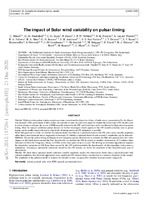| dc.contributor.author | Serylak, M | |
| dc.contributor.author | Tiburzi, C | |
| dc.contributor.author | Shaifullah, G.M | |
| dc.date.accessioned | 2021-05-17T13:33:44Z | |
| dc.date.available | 2021-05-17T13:33:44Z | |
| dc.date.issued | 2021 | |
| dc.identifier.citation | Serylak, M. et al. (2021). The impact of solar wind variability on pulsar timing.Astronomy and Astrophysics, 647,A84 | en_US |
| dc.identifier.issn | 0004-6361 | |
| dc.identifier.uri | 10.1051/0004-6361/202039846 | |
| dc.identifier.uri | http://hdl.handle.net/10566/6161 | |
| dc.description.abstract | Context. High-precision pulsar timing requires accurate corrections for dispersive delays of radio waves, parametrized by the dispersion measure (DM), particularly if these delays are variable in time. In a previous paper, we studied the solar wind (SW) models used in pulsar timing to mitigate the excess of DM that is annually induced by the SW and found these to be insufficient for high-precision pulsar timing. Here we analyze additional pulsar datasets to further investigate which aspects of the SW models currently used in pulsar timing can be readily improved, and at what levels of timing precision SW mitigation is possible. Aims. Our goals are to verify: (a) whether the data are better described by a spherical model of the SW with a time-variable amplitude, rather than a time-invariant one as suggested in literature, and (b) whether a temporal trend of such a model's amplitudes can be detected. Methods. | en_US |
| dc.language.iso | en | en_US |
| dc.publisher | EDP Sciences | en_US |
| dc.subject | Gravitational waves | en_US |
| dc.subject | ISM: general | en_US |
| dc.subject | Pulsars: general | en_US |
| dc.subject | Solar wind | en_US |
| dc.title | The impact of solar wind variability on pulsar timing | en_US |
| dc.type | Article | en_US |

